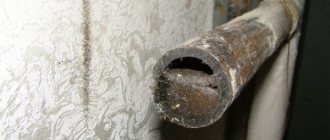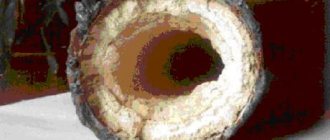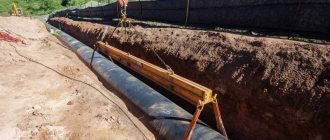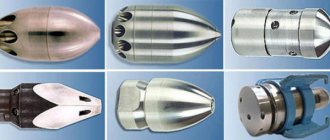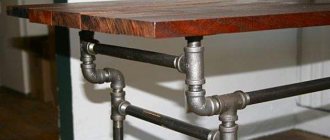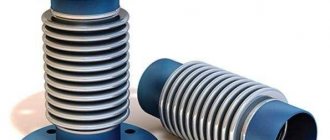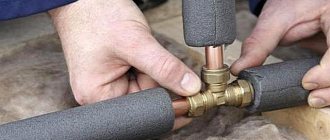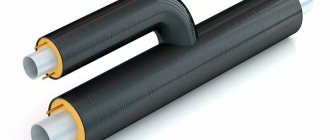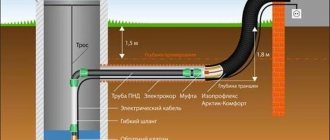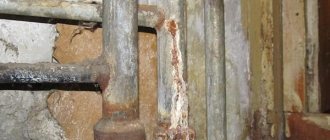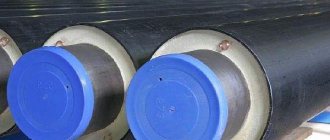Over time, problems can arise in any plumbing system. The pressure drops, the clearance in the pipes decreases, and the water does not drain well. This is due to the composition of the water, the presence of clogging particles in it (sand, debris, stones, salt deposits, fat particles), which settle on the internal walls of communications.
In order for the system to function smoothly, water supply pipelines must be disinfected at least once a year.
Four cases in which water pipes need to be cleaned
- The system has been in operation for a long time, but during this time the pipelines have not been cleaned of deposits. Preventive treatment is carried out once a year. In food production plants, kitchens, canteens, car washes, etc., where there are no sand and grease traps, pipelines are washed and disinfected more often.
- The communication gap has decreased. This happens more often with metal pipes: the metal is rough, deposits and blockages form quickly. The inner surface of plastic pipes is smooth, fewer particles accumulate on it, but over time they accumulate on the plastic.
- Water quality. The lower it is, the more often washing and disinfection of water supply pipelines is required. Water containing suspensions, fractions, sand provokes the formation of blockages. Also, due to the composition of the water, corrosion processes can begin in metal communications; rust treatment is required. Important: this can be avoided by installing a filtration system, but then the filter must be cleaned regularly.
- Errors in the assembly of pipeline systems. So, due to the small slope, the outflow is poor, water accumulates and stagnates, and a “plug” is formed. If the socket is installed against the flow of drains, a blockage appears. The use of unsuitable fittings, violation of assembly technology, especially for pipes made of different materials - all this also leads to clogging and requires cleaning of the pipeline cavity.
Causes of clogged pipes
The throughput often decreases due to build-up in the inner part of the wiring surface; I would like to include the following factors as common reasons:
- Limestone deposits, this element is introduced into the liquid as an antiseptic for disinfection at the DFS.
- The formation of corrosion, rust can spread so much that the permeability of the pipe is reduced to “0”.
- Natural components, salt is a natural impurity in liquids, often abundant formations can be seen after the use of wells or wells.
- Failure of the filter station, solid particles in this situation directly enter the water supply system and settle on the walls.
In most situations, you can eliminate the decrease in pressure yourself; this does not require special skills or a lot of time.
Mechanical cleaning of pipelines
It is suitable for working with those parts of the structure that are in the public domain. The technique allows you to cope with simple blockages. Important: on an old pipeline where the blockage occurred due to poor water quality, the mechanical method is ineffective. But you can cope with this.
Option #1: tapping. Take a heavy object (such as a hammer). Tapping every centimeter, inspect the open part of the pipeline. Impacts will cause vibrations to spread through the system, loosely adhering dirt, rust and scale will move away from the walls. At the end of the procedure, open both taps and apply maximum pressure: this will clean the pipeline system of residual fractions.
Option #2: plunger. This method of cleaning a pipeline is suitable if the problem is located near the drain hole. Place the bowl of the plunger over the drain, grab the handle and begin to make progressive movements evenly. This creates a hydraulic shock, due to which large and small fractions of waste are pushed deep into the pipeline. To enhance the effect, open the tap after the procedure. The plunger can be replaced with a pneumatic gun - this is an improved version of it.
Both options are used in everyday life, but they are not always harmless. Tapping pipes can damage them, and a plunger or air gun is only suitable for removing blockages close to the drain. Chemical cleaning of water pipes gives more reliable results.
Pipeline flushing methods
To solve a problem that requires cleaning in the bathroom, sink, kitchen sink, toilet, or to avoid unpleasant leaks on the surface of the pipe in the bathroom, it is worth taking some measures in advance.
In apartment buildings, manipulation will be somewhat more difficult, but still possible. There are several proven and effective methods; I would like to introduce you in more detail to the question of how to clean plastic drain pipes.
Mechanical cleaning
The advantages include the minimum of preparatory measures for this process and an environmentally friendly environment during the work; the cost of the manipulation will not seem too high, even when it comes to fire wiring. To implement the plan, specially designed metal cables and brushes are introduced into the internal cavity.
It is possible to use nozzles gently to clean the communication from limestone deposits; in this case, they are rubber. To bring the device into the most productive state, winches are used; all deposits are quite simply removed.
Cleaning with hydrochloric and citric acid
The method will require special care in relation to the process; the chemical compositions are quite concentrated and can harm the mucous membrane of the eye, respiratory tract and human skin with their vapors.
Clearing clogged water supply pipes occurs blindly, so I do not consider this operation to be the most effective. There is also a myth that the composition can corrode cast iron pipes; although the danger is dubious, I believe some gaskets can be damaged.
Hydrodynamic flushing
This type of mechanical solution to the problem has a fairly powerful effect, but will require special equipment for networks. After all, to achieve a good result you will need a high pressure of 200 atmospheres. A water jet is created, it washes away all deposits in the inside of the pipe and removes the blockage; flushing the pipeline is quite painstaking work, which involves a number of specific actions.
Hydrochemical flushing
The principle of manipulating the disinfectant effect is somewhat similar to the previous method, but before starting the process, specialists calculate the degree of contamination, conduct hydraulic tests and select a chemical reagent.
After which the product is applied under pressure to the problem area, the most complex excesses in the system are quite easily solved in this way, but the operation cannot be called environmentally friendly, since all substances have a strong effect and can easily leave a mark on the skin after one touch.
Hydropulse washing
I would like to immediately draw your attention to the fact that this method can be used in multi-apartment buildings where the pipeline diameter is at least 30 mm. The cleaning method is quite common; using it, you can easily get rid of blockages such as:
- Fat deposits.
- Soleil.
- Rust.
- Scale.
The principle of operation is to create pulses that are not critical for connections between pipes together with the water supply; a jet under pressure acts on deposits and eliminates them, simultaneously washing them out of the system. The building codes prescribed in SNiP do not prohibit the use of this method.
Breaking through under water pressure
A column of liquid under pressure is capable of washing out a lot of deposits known to people, even in fire-fighting units; to organize the process, you will need special equipment capable of creating the necessary flow of water.
The application cannot be called gentle, so I do not recommend using such manipulations to clean the water supply prefabricated plastic sewage system or sewage systems. The pipe can easily be damaged; it is often held in place by rubber gaskets and hung on clamps, so it is better to use the method for metal or soldered systems.
Cleaning a water pipe using a cable
A special device in the form of a thin soft steel rod is equipped with a special handle at the end to give it rotational movements. At the end of such a cable, according to the rules, various attachments are attached. The method is suitable for a pipeline with a small pipe diameter, but to implement the plan, I would advise choosing a device of maximum length, which will be convenient to work with and will reach the extreme point of the system with a blockage.
Using a plunger
Every owner has a plunger in his house; the principle of eliminating the problem is to use a special device at a minimum cost. As soon as you remove the rubber tip after pumping water to the highest point, it will flow back and bring the entire mass down onto the resulting plug.
Note! Storage tanks for water supply of a country house
The method is quite simple and effective; it can be used at home for minor stains. To achieve maximum effect, before starting the process it is worth adding a special chemical that will soften the deposits that have formed.
Ultrasonic cleaning
For such cleaning of internal contaminants, ultrasonic vibrations are used using one of the available methods. These auxiliary actions are sent along with the liquid to the point of blockage of the fire water supply or other communication. The quality of work using this technique improves significantly.
Chemical cleaning of pipelines
You can use chemicals to disinfect pipes yourself. There are many clog removers available in stores.
In this case, work is carried out in four stages:
- preliminarily use a plunger to remove stagnant water in the pipe;
- the drug is poured or poured into the water supply system;
- within the specified time (usually no more than 20 minutes) the chemical works;
- Upon completion, you must open the taps all the way and flush the system with plenty of water.
The good thing about this method is that it does not require physical effort. It is impossible to break or damage anything in the pipe (as is the case with tapping). But aggressive soda, which is included in the formula of most drugs, corrodes metal and plastic, so its use is often not recommended.
Chemical cleaning removes food debris or grease plugs. But it is ineffective against scale, sand, and rust. It also cannot cope with large blockages; it only works with medium and small ones. To remove a large blockage, call the service.
Flushing the water supply and removing blockages: goals and means
Why and how are water mains flushed? Are there any instructions for doing this? Is it possible to somehow clean the water supply if its permeability after several years of operation has catastrophically decreased? Let's figure it out.
The operation of a new water supply line begins... with its flushing.
Let's immediately separate the flies from the cutlets, so to speak.
- Testing and flushing of the yard water supply network is carried out as part of the transfer of the facility from the construction to the operating organization . The pipeline is pressure tested, checked for leaks, cleaned of debris and foreign objects and disinfected.
Important: cold water supply is positioned as drinking water, which implies strict requirements for the composition of the water.
- If the throughput of the water supply system is significantly lower than the norm for a pipe of a given diameter, it needs mechanical cleaning or chemical washing with reagents that dissolve lime deposits and rust . The use of hydropneumatic flushing in this case, as a rule, does not bring any results.
Water supply pipes become overgrown with lime and rust.
Professional cleaning and disinfection of water supply pipes
The cleaning service employs specialists who know the specifics of pipeline communications in different areas of Moscow. They understand what means are used in a particular case. Employees have equipment at their disposal that removes large blockages without causing damage to the system.
Specialists also disinfect the internal walls. Chemical and mechanical cleaning only dissolve the accumulation of particles and push them further through the water supply. It is possible that the blockage will form again in this place, because... the reason has not been eliminated.
Employees of a specialized company clean scale, grease, rust, scale, etc. from the internal walls, so the clearance of communications increases. Disinfection is carried out, i.e. bacteria are eliminated.
Upon completion of the work, the employee issues a guarantee. There will be no problems with the pipeline during the period specified in the document.
Features of water supply cleaning methods
specializes in cleaning and flushing hot and cold water pipelines using the most modern technological equipment and methods such as:
- hydropneumatic : consists of cleaning water pipelines using the water-air washing method (injected compressed air is supplied to the water supply system simultaneously with the flow of water);
- hydromechanical : carried out by passing a special cleaning device (flexible cleaning pistons are often used) through the water supply under the influence of water pressure;
- hydrodynamic : with the help of a high-speed flow of water, all deposits formed on the walls of the water supply system are effectively washed away;
- chemical : based on the use of organic reagents that can dissolve all kinds of substances, rust, accumulated on pipe machines, without having a negative deformation effect on them.
Qualified employees, using a combination of different methodological techniques, will clean your water supply from all kinds of contaminants and deposits in the shortest possible time.
Who needs cleaning and why?
Sewage systems are an integral part of cottages and multi-storey buildings. They must be installed at public service facilities. Sewage systems are used by employees of industrial companies.
Without such communication, it is difficult to imagine how a whole range of production processes will be carried out. The sewer system requires regular maintenance. For its normal operation, maintaining communications in good condition, flushing the pipeline is used. The optimal option for cleaning communications is selected by specialists.
Types of pollution
Contaminants form on the inner surface of pipelines as a result of the operation of structures. During use, all kinds of deposits are formed on the pipe walls: soap, fatty acids, hydrocarbons, impurities of all kinds of mechanical impurities, wax, burnt vegetable and animal fats, mineral deposits, fuel oil, etc.
Any deposit can be cleaned either independently or by professional companies. But all contaminants in the pipeline must be removed.
Why should pipelines be cleaned for any contamination?
There are such blockages when it is necessary to take emergency cleaning measures in order to restore the functioning of critical communication systems. However, partial contamination of worker threads can also lead to big troubles:
- Accumulation of contaminants in pipes, preventing rapid drainage.
- The appearance of noise.
- The penetration of rust and other mechanical impurities from the water supply system into food and drinks.
- Scale formation, the danger of which is the formation of harmful bacteria and microorganisms.
- Reducing the performance of the heating system by reducing the diameter of the pipes.
Such troubles cannot be ignored - they must be eliminated. The appropriate technique is selected depending on the type and complexity of the problem.
Water supply areas most susceptible to clogging
Most of the polluting sediments accumulate where the speed of water movement decreases sharply, as well as in places with resistance to flow movement. These include:
- pipeline sections with changes in diameter;
- pipeline fittings (except for straight-through ball valves);
- mechanical cleaning filter in front of the meter;
- check valves;
- water meters;
- mixer filter.
Active deposition of all types of contaminants can occur on the uneven surface of old metal pipes.
Our advantages
You can order sewer cleaning services from the Sanepidemiological Station Moscow company. By contacting us, you will find a solution to your problem. Advantages of SES Moscow:
- Professional problem solving.
- All activities of the company are regulated by law.
- Carrying out preventive measures.
- Affordable prices.
- Choosing effective work methods.
- Study of the modern market and analysis of consumer power.
- Cooperation with reliable manufacturers.
- Analysis of the latest developments.
- Professional and experienced team.
- Resolution of issues 100%.
Contact the specialists of SES Moscow for high-quality pipeline cleaning services. Our company strives to make your life convenient and comfortable.
SES company specialists will identify the problem and do everything possible to prevent the unpleasant situation from happening again in the future. We use reliable, accurate and state-of-the-art equipment that helps us effectively solve any sewer problem. We will clean pipelines of even the most complex configuration, regardless of the length and size of the pipes. The SES company guarantees maximum safety and effectiveness of the methods used in the company.
Sanitary and Epidemiological Station Certificates
Removing blockages
Dealing with clogged pipes in a cold water supply system is very different from flushing a heating system or cleaning a sewer. The key difference is that the blockage cannot be destroyed by a stream of water or weak mechanical action: the pipes are overgrown with durable lime deposits and rust.
However: sometimes the initial cause of a blockage is sand or a piece of scale. If it is not removed immediately, after some time the blockage becomes cemented and can be destroyed with great difficulty.
Is it possible to do something with your own hands if the water pressure in a house with an old steel water supply has dropped catastrophically?
- Try plugging the faucet with your finger and simultaneously fully open the cold and hot water taps. DHW pressure is noticeably higher most of the year; the counterflow can destroy a fresh blockage, after which its fragments will be carried out by water into the sewer.
- If this does not help, repeat the operation by resetting the cold water riser. The pressure difference between the hot water supply and the empty riser will be significantly greater.
- Is the water still not flowing at normal pressure? Open the valve (with the riser down, of course). Debris deposits under the valve seat are a common problem with cast iron and, to a lesser extent, brass screw valves.
Please note that ball valves do not suffer from blockages. There are simply no pockets in their body where debris accumulates.
- Finally, if all else fails, try disassembling all available threaded connections and cleaning the pipe with a steel wire from the curtain rod, bending a hook the size of a pinhead at its end. On the second side of the string a handle is formed, resembling a well gate. The string is fed into the pipe with continuous rotation; after it passes the blockage, its remains are washed with water.
Tip: lime deposits dissolve well with acid solutions. It is enough to plug the pipe near the valve and fill it with the reagent for a couple of hours. As an active substance, you can use imported Cillit or, which is much better, a solution of dry oxalic acid: its price is several times lower with much greater chemical activity.
Oxalic acid solution perfectly dissolves lime and rust.
When to call a specialist
If you have never dealt with pipes, faucets, or household appliances, then call a plumber right away. You will have to contact a specialist if you were unable to clear the communications on your own. Perhaps your pipes are so clogged with deposits that they can only be replaced.
We recommend that you read: Using copper pipes in various pipeline systems - pros and cons
By replacing steel water pipes once with new ones, you will save yourself from problems with water supply to your apartment for decades.
